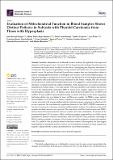Por favor, use este identificador para citar o enlazar a este item:
http://hdl.handle.net/10261/340285COMPARTIR / EXPORTAR:
 SHARE SHARE
 CORE
BASE CORE
BASE
|
|
| Visualizar otros formatos: MARC | Dublin Core | RDF | ORE | MODS | METS | DIDL | DATACITE | |

| Título: | Evaluation of Mitochondrial Function in Blood Samples Shows Distinct Patterns in Subjects with Thyroid Carcinoma from Those with Hyperplasia |
Autor: | Bernal-Tirapo, Julia; Bayo, Mª Teresa; Yuste-García, Pedro; Córdova, Isabel; Peñas, Ana; García-Borda, Francisco José; Quintela, Cesar; Prieto, Ignacio CSIC ORCID; Sánchez-Ramos, Cristina CSIC ORCID; Ferrero-Herrero, Eduardo; Monsalve, María CSIC ORCID | Palabras clave: | Metabolism Mitochondria Cancer Thyroid Diagnostic |
Fecha de publicación: | 2023 | Editor: | Multidisciplinary Digital Publishing Institute | Citación: | International Journal of Molecular Sciences 24(7): 6453 (2023) | Resumen: | Metabolic adaptations are a hallmark of cancer and may be exploited to develop novel diagnostic and therapeutic tools. Only about 50% of the patients who undergo thyroidectomy due to suspicion of thyroid cancer actually have the disease, highlighting the diagnostic limitations of current tools. We explored the possibility of using non-invasive blood tests to accurately diagnose thyroid cancer. We analyzed blood and thyroid tissue samples from two independent cohorts of patients undergoing thyroidectomy at the Hospital Universitario 12 de Octubre (Madrid, Spain). As expected, histological comparisons of thyroid cancer and hyperplasia revealed higher proliferation and apoptotic rates and enhanced vascular alterations in the former. Notably, they also revealed increased levels of membrane-bound phosphorylated AKT, suggestive of enhanced glycolysis, and alterations in mitochondrial sub-cellular distribution. Both characteristics are common metabolic adaptations in primary tumors. These data together with reduced mtDNA copy number and elevated levels of the mitochondrial antioxidant PRX3 in cancer tissue samples suggest the presence of mitochondrial oxidative stress. In plasma, cancer patients showed higher levels of cfDNA and mtDNA. Of note, mtDNA plasma levels inversely correlated with those in the tissue, suggesting that higher death rates were linked to lower mtDNA copy number. In PBMCs, cancer patients showed higher levels of PGC-1α, a positive regulator of mitochondrial function, but this increase was not associated with a corresponding induction of its target genes, suggesting a reduced activity in cancer patients. We also observed a significant difference in the PRDX3/PFKFB3 correlation at the gene expression level, between carcinoma and hyperplasia patients, also indicative of increased systemic metabolic stress in cancer patients. The correlation of mtDNA levels in tissue and PBMCs further stressed the interconnection between systemic and tumor metabolism. Evaluation of the mitochondrial gene ND1 in plasma, PBMCs and tissue samples, suggested that it could be a good biomarker for systemic oxidative metabolism, with ND1/mtDNA ratio positively correlating in PBMCs and tissue samples. In contrast, ND4 evaluation would be informative of tumor development, with ND4/mtDNA ratio specifically altered in the tumor context. Taken together, our data suggest that metabolic dysregulation in thyroid cancer can be monitored accurately in blood samples and might be exploited for the accurate discrimination of cancer from hyperplasia. | Versión del editor: | http://dx.doi.org/10.3390/ijms24076453 | URI: | http://hdl.handle.net/10261/340285 | DOI: | 10.3390/ijms24076453 | ISSN: | 1661-6596 | E-ISSN: | 1422-0067 |
| Aparece en las colecciones: | (IIBM) Artículos |
Ficheros en este ítem:
| Fichero | Descripción | Tamaño | Formato | |
|---|---|---|---|---|
| Evaluation_of_Mitochondrial_Bernal_PV_Art2023.pdf | 4,82 MB | Adobe PDF |  Visualizar/Abrir |
CORE Recommender
SCOPUSTM
Citations
1
checked on 24-abr-2024
WEB OF SCIENCETM
Citations
1
checked on 29-feb-2024
Page view(s)
18
checked on 30-abr-2024
Download(s)
9
checked on 30-abr-2024
Google ScholarTM
Check
Altmetric
Altmetric
Este item está licenciado bajo una Licencia Creative Commons

